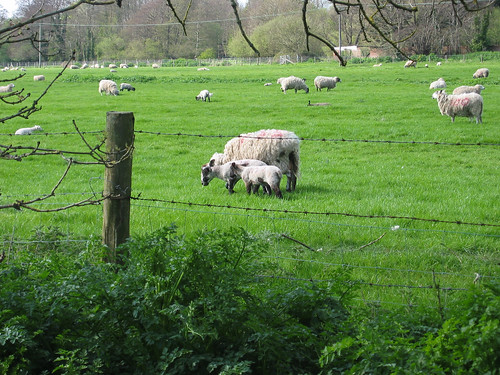
{Photos of Dorsetshire by rocketlass.}
When I went to shelve Tess of the D'Urbervilles tonight I realized that I first needed to add one more post to the string inspired by my recent re-reading of this most heartfelt of Thomas Hardy's novels.
I wrote a bit already about Hardy's tinkering with the text between the novel's first appearance in 1891 in the Graphic and its inclusion in the Wessex edition of his works in 1912. The most obvious and important changes Hardy introduced were to the relationship between Tess and Alec, but another set of alterations seems worth noting, particularly for a reader coming to the book more than a century later. As David Skilton, editor of the 1978 Penguin Classics edition, explains,
On the whole there is an increase in dialect and colloquialism in the dialogue between the 1891 and 1912. . . . The spoken language is generally rather neater, more economical, and less "literary" in the later version.The increased employment of dialect, alongside the occasional added reference to some old country practice--such as Angel Clare's wearing of a cabbage leaf under his hat to keep cool, which only appears in the 1912 edition--suggests that Hardy revised with an eye towards preserving details of a way of life that, in the decades since Tess's first publication, had almost entirely disappeared.
Even at the time of writing, Hardy was aware that the old country ways, having held from time immemorial, were slipping away, obsolescent in the face of the machine age. Late in the novel Hardy writes of the increasing hubbub of Old Lady-Day, when farm laborers who want to change situations moved to their new homes:
These annual migrations from farm to farm were on the increase here. When Tess's mother was a child the majority of the field-folk around Marlott had remained all their lives on one farm, which had been the home also of their fathers and grandfathers; but latterly the desire for yearly removal had risen to a high pitch.At the same time, Hardy explains, the villages were also being depopulated, their non-farm residents--carpenters, smiths, and other skilled workers--were being forced out; when their leaseholds expired, which often happened on the death of the head of the family, their cottages were torn down, the land beneath them going under the plow. As Hardy explains,
These families, who had formed the backbone of village life in the past, who were the depositaries of the village traditions, had to seek refuge in the large centres; the process, humorously designated by statisticians as "the tendency of the rural population towards the large towns," being really the tendency of water to flow uphill when forced by machinery.

That passage, written in close to a pure editorial voice, reminds me of Wendell Berry, who takes on the same mission of preservation in his novels. Berry draws on more than a century of unbroken chains of story and memory to recall rural life as it was lived in the years just before and after World War II, when the largely self-contained, pre-petroleum economy still held sway in the more remote hill farms of Kentucky. Berry's belief in that mostly lost way of life as more sustainable, human, and fulfilling than our contemporary industrial culture is implicit in all his fiction, echoed in the relationships of characters to one another and to the land, and in his emphasis on the importance of stewardship in all our interactions.
Berry makes those points explicit in his non-fiction, as in this passage from his essay "People, Land, and Community," collectd in The Art of the Commonplace:
People are joined to the land by work. Land, work, people, and community are all comprehended in the idea of culture. These connections cannot be understood or described by information--so many resources to be transformed by so many workers into so many products for so many consumers--because they are not quantitative. We can understand them only after we acknowledge that they should be harmonious--that a culture must either be shapely and saving or shapleless and destructive. To presume to describe land, work, people, and community by information, by quantitites, seems invariably to throw them into competition with one another. Work is then understood to exploit its people. And then instead of land, work, people, and community, we have the industrial categories of resources, labor, management, consumers, and government. We have exchanged harmony for an interminable fuss, and the work of culture for the timed and harried labor of an industrial economy.It was only when I read Wendell Berry, more than a decade after I left my rural birthplace for Chicago, that I understood how my hometown, like the smaller farming communities around it, had entered upon the decline that, by the time I left, had trimmed its population and largely shuttered its downtown. Berry's accounts, in fiction and nonfiction, showed me what those towns had been as recently as a generation ago, and it made me ache for their loss in a way I never had when I lived there.
The city is my home, and I love it far too much to ever want to leave it, but through Berry's eyes I finally saw what a small town could be even now, if propelled by a dynamic, decidedly local economy. It's a seductive vision, and one that I think Thomas Hardy would recognize and approve.

No comments:
Post a Comment